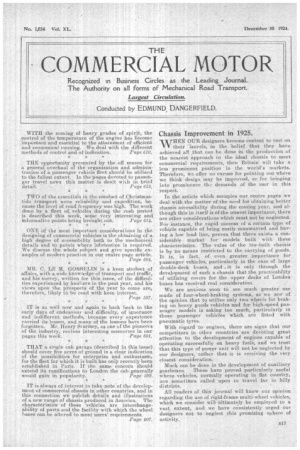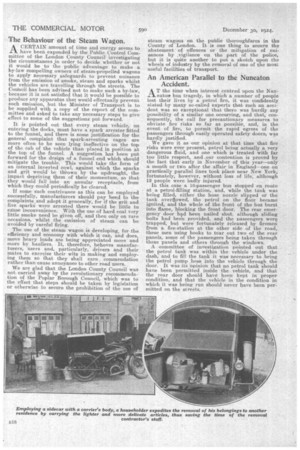Chassis Improvement in 1925.
Page 1

Page 2

If you've noticed an error in this article please click here to report it so we can fix it.
WHEN OUR designers become content to rest on their laurels, in the belief that they have achieved ati ;that can be done in the production of the nearest approach to the ideal chassis to meet commercial requirements, then Britain will take a less prominent position in the world's markets. Therefore, we offer no excuse for pointing out where we think design may be improved, or for bringing into prominence the demands of the user in this respect.
In the article which occupies our centre pages we deal with the matter of the need for obtaining better chassis accessibility during the coming year, and although this in itself is of the utmost importance, there are other considerations which' must not be neglected. For instance, the rapid success of a certain type of vehicle capable of being easily manceuvred and having a low load line, proves that there exists a considerable market for models built with these characteristics. The value of the low-built chassis is by no means restricted to the carrying of goods. It is, in fact, of even greater importance for passenger vehicles, particularly in the ease of large double-deck buses, and it is only through the development of such a chassis that the, practicability of utilizing covers for the upper decks of London buses has received real consideration.
We are anxious soon to see much greater, use made of four-wheel-braking systems, as we ar of. the opinion that to utilize only two wheels for braking on heavy goods vehicles and for high-speed passenger models is asking too much, particularly in those passenger vehicles which are fitted with pneumatic tyres.
• With regard to engines, there are signs that our competitors in other countries are devoting great attention to the development of engines capable of operating successfully on heavy fuels, and we trust that this type of power unit' will not be neglected by our designers, rather that it is receiving the very closest consideration.
Much can be done in the development of auxiliary gearboxes, These have proved particularly useful where vehicles, normally operating in flat country, are sometimes called upon to travel far in hilly d istriets.
All readers of this journal will know our opinion regarding the use of rigid-frame multi-wheel vehicles, which we consider willultimately be employed to a, vast extent, and we have consistently urged our designers not to neglect 'this promising sphere of activity.
The Behaviour of the Steam Wagon.
ACERTAIN amount of time and energy seems to have been expended by the Public Control Committee of the London County Council investigating the circumstances in order to decide whether or not it would be to the public advantage to make a by-law compelling owners of steam-propelled wagons to apply necessary safeguards to prevent nuisance from the emission of smoke, steam and sparks whilst the vehicles are travelling through the streets. The Council has been advised not to make such a by-law, because it is not satisfied that it would be possible to produce any apparatus that would effectually prevent such emission, but the Minister of Transport is to be supplied with a copy of the report of the committee and asked to take any necessary steps to give effect to some of the suggestions put. forward.
It is pointed out that every steam vehicle, on entering the docks, must have a spark arrester fitted to the funnel, and there is some justification for the general complaint that spark-arresting cages are more often to be seen lying ineffective on the top of the cab of the vehicle than placed in position at the top of the funnel. A suggestion has been put forward for the design of a funnel end which should mitigate the trouble. This would take the form of an internal inverted cowl, against which the sparks and grit would be thrown by the updraught, the impact depriving them of their momentum, so that they would fall into an annular receptacle, from which they could periodically be cleared.
If some such contrivance as this can be employed successfully, manufacturers should pay heed to the complaints and adopt it generally, for if the grit and live sparks were arrested there would be little to cdruse inconvenience. With the use of hard coal very little smoke need be given off, and then only on rare occasions, whilst the emission of steam can be avoided by careful firing.
The use of the steam wagon is developing, for the efficiency and economy with which it can, and does, move heavy loads are being appreciated more and more by hauliers. It, therefore, behoves manufacturers, users and, particularly, drivers and their mates to exercise their wits in making and employing them so that they shall earn commendation rather than cause annoyance to other road users.
We are glad that the London County Council was not carried away by the revolutionary recommendation of the Poplar Borough Council, which was to the effect that steps should be taken by legislation or otherwise to secure the prohibition of the use of
steam wagons on the public thoroughfares in the County of London. It is one thing to secure the abatement of offences or the mitigation of nuisances by ;vigilance on the part of the police, but it is quite another to put a sketch upon the wheels of industry by the removal of one of the most useful facilities of transport.
An American Parallel to the Nuneaton Accident.
A T the time when interest centred upon the Nunileatort bus tragedy, in which a number of people lost their lives by a petrol fire, it was confidently stated by many so-called experts that such an accident was so exceptional that there was hardly any possibility of a similar one occurring, and that, consequently, the call for precautionary measures to obviate fire risks so far as possible, and, in the event of fire to permit the rapid egress of the passengers through easily operated safety doors; was hardly justified. We gave it as our opinion at that time that fire risks were ever present, petrol being actually a very dangerous fluid, and one which is treated with far too little respect, and our contention is proved by the fact that early in November of this year—only a month or two after the affair in England—one on practically parallel lines took place near New York, fortunately, however, without loss of life, although 12 people were badly injured.
In this case a le-passenger bus stopped en route at a petrol-filling station, and, while the tank was being filled, either the hose nozzle slipped or the tank overflowed, the petrol on the floor became ignited, and the whole of the front of .the bus burst into flame, blocking the front door. The rear emergency door hd been nailed shut, although sliding bolts had been provided, and the passengers were trapped, but were fortunately released by firemen from a fire-station at the other side of the road, these men using hooks to tear out two of the rear panels, some of the passengers being taken through these panels and others through the windows. A committee of investigation pointed out that the petrol tank was within the vehicle under the dash, and to fill the tank it was necessary to bring the petrol pump hose into the vehicle through the door. It was its opinion that no petrol tank should have been permitted inside the vehicle, and that the rear door should have been kept in proper condition, and that the vehicle in the condition in which it was being run should never have been permitted on the streets..






























